产品详情
简单介绍:
GST Monoclonal Antibody
详情介绍:
Tag/Control Antibodies
GST Monoclonal Antibody
¥1,200
Recombinant GST Protein
mouse
ELISA, WB; Recommended dilution: WB:1:500-1:5000
Genetic engineers have used glutathione S-transferase to create the GST gene fusion system. This system is used to purify and detect proteins of interest. In a GST gene fusion system, the GST sequence is incorporated into an expression vector alongside the gene sequence encoding the protein of interest. Induction of protein expression from the vector's promoter results in expression of a fusion protein: the protein of interest fused to the GST protein. This GST-fusion protein can then be purified from cells via its high affinity for glutathione. GST is commonly used to create fusion proteins. The tag has the size of 220 amino acids (roughly 26 KDa), which, compared to other tags like the myc- or the FLAG-tag, is quite big. However, many commercially-available sources of GST-tagged plasmids include a thrombin domain for cleavage of the GST tag during protein purification.
monoclonal
IgG2b
>95%, Protein G purified
Non-conjugated
Preservative: 0.03% Proclin 300Constituents: 50% Glycerol, 0.01M PBS, PH 7.4
liquid
Upon receipt, store at -20°C or -80°C. Avoid repeated freeze.

Western blot
All lanes : Recombinant GST Protein at 30ng/ml
Line 1: Mouse Anti-GST monoclonal antibody at 1:1000
Line 2: Mouse Anti-GST monoclonal antibody at 1:2000
Line 3: Mouse Anti-GST monoclonal antibody at 1:5000
Line 4: Mouse Anti-GST monoclonal antibody at 1:10000
Line 5: Mouse Anti-GST monoclonal antibody at 1:20000
Line 6: Mouse Anti-GST monoclonal antibody at 1:40000
Line 7: Mouse Anti-GST monoclonal antibody at 1:80000
Predicted band size : 28 kd
Observed band size : 28 kd
Glutathione S-Transferase, gst, GST tag
相关文章












